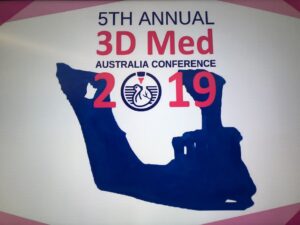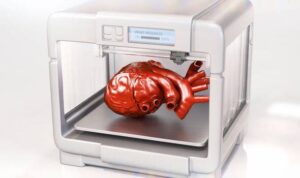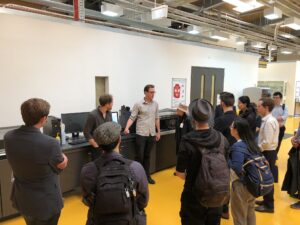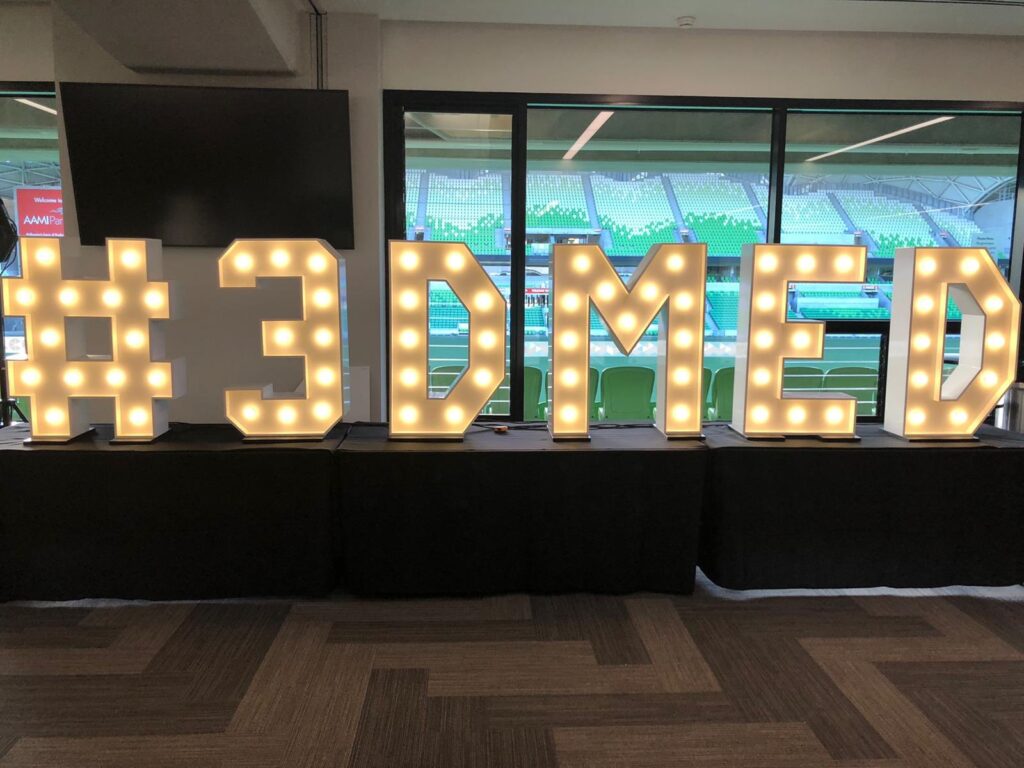Australia’s 3D Printing Medical Conference: Focusing on Technology and Teamwork to Advance the Field
 Why has nobody really 3D printed a heart yet? Will animals also benefit from 3D printing in the veterinary field? How to start a 3D printing lab in a public hospital? And who is Gary? These are just a few of the proposals answered at the latest and fifth edition of the 3D Med Australia Conference, which concluded last Saturday after three days of workshops, lab tours, and lectures at the AAMI Park, a huge Stadium in Melbourne. The event highlighted 3D printing applications in various health areas like presurgical planning in adult and pediatric fields, bioprinting, medical device design, prosthetic and implantable device design, education of trainees and medical students, as well as patient experience, and even 3D printing to support longevity of equipment for helicopter retrieval (from blood warmers to vial containment).
Why has nobody really 3D printed a heart yet? Will animals also benefit from 3D printing in the veterinary field? How to start a 3D printing lab in a public hospital? And who is Gary? These are just a few of the proposals answered at the latest and fifth edition of the 3D Med Australia Conference, which concluded last Saturday after three days of workshops, lab tours, and lectures at the AAMI Park, a huge Stadium in Melbourne. The event highlighted 3D printing applications in various health areas like presurgical planning in adult and pediatric fields, bioprinting, medical device design, prosthetic and implantable device design, education of trainees and medical students, as well as patient experience, and even 3D printing to support longevity of equipment for helicopter retrieval (from blood warmers to vial containment).“3D technologies, including 3D printing and augmented reality, are set to radically transform the way we teach, train, plan, rehearse, and perform surgery; and Australia is lining up to be one of the leaders in the field,” said Chuen. “We are proud to support this by bringing together all of these great minds: from what I can see, Australia, and Melbourne, in particular, will be a major hub of medical technology development, and 3D related technologies will be a key part of this.”
Atandrila Das, General Surgeon at Northern Health, Melbourne, presented a world-first case combining 3D visualization with robotic cancer surgery, which was a result of a collaboration between Austin Health and the Peter MacCallum Cancer Center’s Department of Surgery doctoral students and surgeons. In addition, Claudia di Bella, Orthopaedic Surgeon, and researcher at Biofab3D in St Vincent’s Hospital at The University of Melbourne exhibited her robotics and tissue engineering work.
Additionally, ethics and regulation were a big part of the event, with attendees getting updates from Australian governing bodies like the Therapeutic Goods Administration (TGA), the Department of Health and Human Services (DHHS), and Medical Device Innovation. The TGA’s John Skerritt provided leading researchers with an update on the current changes to custom medical device and implant regulations coming in late November. Some of the proposals for change include a ‘medical device production system’ framework to allow healthcare providers to produce lower risk personalized devices without manufacturing certification and regulation of medical devices with a human origin component as medical devices with a biological component rather than biologicals.

What is wrong with this image? O’Connell explains why nobody has really 3D printed a heart yet (Image Credit: Cathal O’Connell)
During the talk ‘Don’t Print Your Heart Out’, facility manager at BioFab3D, Cathal O’Connell, dissected the hype from reality and explained why nobody has really 3D printed a heart yet, suggesting it is dangerous to provoke so much buildup in platform technologies and how clinicians, scientists, and reporters need to be careful when delivering their message on medical technologies.
“In the original printed “heart” scientific paper, Israeli scientists describe […] the main focus was to print a square “patch” of heart cells and blood vessels using a “personalized” bioink. As a final flourish, the team also printed the cells into a thumbnail-sized, heart shape. The text of the original paper clearly states the printed heart-shaped structure is not a real heart and lacks most of the features required to make a heart work. This is impressive work – the cardiac patches may indeed turn out to be an important development in the field. I’m more worried about media reports giving the impression that our field of research is far more advanced than it is,” said O’Connell.
While Blake Cochran, from the University of New South Wales (UNSW), Sydney, introduced Gary, a 3D printed radiologically realistic skull, and Stewart Ryan, from The University of Melbourne University’s vet school, explored the importance of 3D printing for the training of veterinary surgeons for all creatures great and small, and Ryan should know, he has even performed surgery for a 14-year old tiger at the Melbourne Zoo to remove a cancerous tumor.
As part of the event, the inaugural Women in 3D Technologies networking drinks were held in partnership with the Commonwealth Scientific and Industrial Research Organisation (CSIRO), with Elizabeth Sigston (a leading head and neck cancer surgeon) giving the keynote speech. The conference proved that there is a strong representation of women in STEMM careers across Medicine, Dentistry and Health Sciences (MDHS) in Melbourne.
“3D technologies are the natural next steppingstone in the era of personalised medicine,” said Coles-Black. “Australian doctors, engineers and other researchers need to come together in order to make the most of this new frontier in medicine. Our conference provides a collegiate environment for much-needed multidisciplinary collaboration.”

Jason Chuen, Elizabeth Sigston, Frank McGuire, and Jasamine Coles-Black at the 3D Med Conference (Image Credit: Austin 3D Med Lab)
Coles-Black also explained that “this conference seeks to bring together experts to solve the often-quoted barriers to the adoption of 3D printing technologies in healthcare settings, such as the lack of technical and regulatory knowledge, perceived costs, and lack of expertise in implementation.”
In addition, the conference featured a tour of the new MDHS SBS Digital Learning Hub. Other University of Melbourne labs featured through hands-on tours included the Melbourne School of Design’s NExT Lab and BioFab3d, Austin 3D Med Lab, and the Australian Research Council Training Centre for Medical Implant Technologies (ARC-CMIT)–which launched on November 8. In addition, there was a significant focus on industry, startup and commercialization, and medical device development with representatives from the Medical Device Partnering Program, Stratasys, HP, Evok3D, Kyocera, Leapfrog, Gore, Global3D and Materialise.
“Clinicians and engineers need to work together to develop this technology and find ways to implement it effectively and safely. Collaboration is key in this industry,” claimed Chuen.
During the occasion, there was a lot of hype about the clinical uses of augmented and virtual reality in presurgical planning, medical student education, forensics, trauma simulation, and to improve hospital systems.
At the Anatomical 3D Segmentation Workshop, in collaboration with Evok3D, an HP 3D Partner in Australia, guests learned more about the end-to-end workflows for the production of 3D printed color anatomical models, which can be used to improve pre-surgical planning, patient consultation, and support medical education. Medical 3D technology for patient care is getting more and more accessible, every day, providing patient’s personalized treatment based on their scans as point-of-care 3D printing enables manufacturing directly on location.
Promotional booths were a big part of the event, with visitors looking into how Materialise solutions can provide personalized treatment to patients and guidance on setting up a 3D point-of-care facility at hospitals. And Stratasys even chose the 3D Med Conference to launch its J750 Digital Anatomy Printer in the Australasia region.
The last day of the event kicked off with Mia Woodruff, Professor of Biomedical Engineering at Queensland University of Technology (QUT), and Gordon Wallace, a distinguished professor at the University of Wollongong (UOW), talking about the future of bioprinting. Woodruff shared challenges and motivations to translate biofabrication in the hospital of the future, and along with Wallace announced the Biofabrication 2020 event: “Biofab by the Beach”, set for September 27 through 30, in 2020, proving it’s all about teamwork, something Wallace was keen on emphasizing during his panel, claiming “cross-disciplinary collaboration is key” and “Australia leads the way as Australians are collaborative by nature.” Finally, rounding up the event was Peter Lee, Director of the ARC CMIT, focusing on building the multidisciplinary networks needed to train the new generation of implant engineers. That’s what it was all about at the 3D Med Conference, looking into the future for biotechnology and medical applications that will pave the way for future research and adoption of 3D printing technology.
Discuss this and other 3D printing topics at 3DPrintBoard.com or share your thoughts below.
Subscribe to Our Email Newsletter
Stay up-to-date on all the latest news from the 3D printing industry and receive information and offers from third party vendors.
You May Also Like
Gorilla Sports GE’s First 3D Printed Titanium Cast
How do you help a gorilla with a broken arm? Sounds like the start of a bad joke a zookeeper might tell, but it’s an actual dilemma recently faced by...
Nylon 3D Printed Parts Made More Functional with Coatings & Colors
Parts 3D printed from polyamide (PA, Nylon) 12 using powder bed fusion (PBF) are a mainstay in the additive manufacturing (AM) industry. While post-finishing processes have improved the porosity of...
$25M to Back Sintavia’s Largest Expansion of Metal 3D Printing Capacity Since 2019
Sintavia, the digital manufacturing company specializing in mission-critical parts for strategic sectors, announced a $25 million investment to increase its production capacity, the largest expansion to its operations since 2019....
Velo3D Initiates Public Offering in a Bid to Strengthen Financial Foundations and Drive Future Growth
Velo3D (NYSE: VLD) has been among a number of publicly traded 3D printing firms that have attempted to weather the current macroeconomic climate. After posting a challenging financial report for 2023,...



































